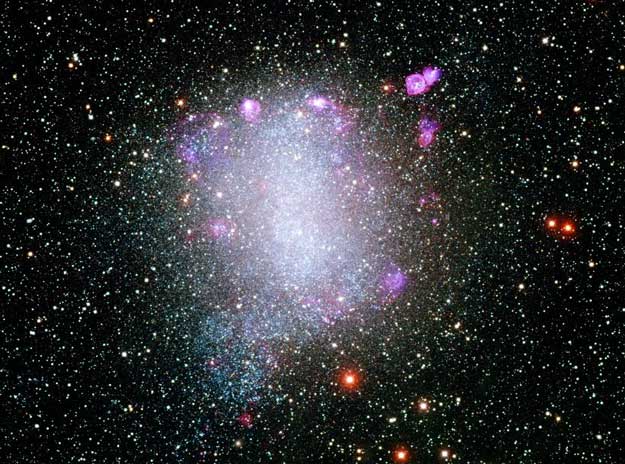
Mel Acheson: Scraps of Cosmic Electricity.
Barnard’s Galaxy is a loose assemblage of a few million stars. (In contrast, the Milky Way is estimated to have several hundred billion.) Because of its shapelessness and small size, it’s classified as an irregular dwarf, one of several dwarf galaxies in the Local Group, a cluster that includes the Milky Way. It lies beyond the center of the Milky Way from us, about as far away as its more famous big sister—or perhaps its mother—M31, the Andromeda Galaxy.
The origin and evolution of dwarf galaxies are not well understood by conventional theory. Speculations attribute them to “close encounters with or ‘digestion’ by other galaxies.” Gradually over millions of years, the feeble caress of gravity is alleged to disturb clouds of gas. The gas collapses into stars, the pressure triggers nuclear fusion, and the stars burn themselves into explosions that send off “ripples of heated matter.” The results are the “regions of rich star formation and curious nebulae” that dot the image.
In the Electric Universe model, Barnard’s Galaxy is understood in the context of intergalactic plasma discharges—a cluster-sized lightning bolt—from M31. The pinch effect of the current pulls in material from the intergalactic medium as well as “jetting” material from galactic cores. It confines and condenses this material into the hydrogen clouds, dwarf galaxies, and high-redshift quasars scattered along a line from the spin axis of M31 toward the Milky Way. (See the “mother” link above.)
As we know from lab experiments, such discharges are messy. They twist around and throw off wisps of plasma. Those heteromacs tend to reproduce at smaller scale the same evolution of instabilities that are seen in the larger-scale channel. At the galactic scale, those wisps would be the irregular dwarf galaxies around the periphery of the primary discharge channel.
They move in response to the electromagnetic forces generated by the discharge, which can be many orders of magnitude greater than gravitational forces. In consequence, the velocities of the galactic wisps may be quite different from what would be expected—or explainable—from gravity. Keeping gravity as the only operative force requires the invention of large amounts of unseen “dark matter” to make up the difference.
These discharges have high voltage differentials, not only along the primary current channel but also within the many induced secondary and tertiary channels along which stars form. The differentials accelerate charged particles just as a particle accelerator does in a lab. In regions of increased density where collisions are apt to occur, such as at the surfaces of stars, nuclear fusion occurs and heavier elements build up. The species and amounts will vary with such factors as the power of the current, so the stars in each wisp may have a different composition. This has been observed to the puzzlement of conventional theorists.
Although the Electric Universe model is conceptually more accurate at explaining and predicting observations, it is not as well suited to mathematical elaboration as conventional theories. Electrical parameters and such things as double layers often require in situ measurements to quantify them. The Electric Universe theorist must be comfortable with open questions and with the humility of “I don’t know.”
Electrical explanations may not engender Emperors of Astronomy to promulgate mathematically precise Ultimate Answers, but neither will the theorists be embarrassed by having the nakedness of obsolete and bankrupt theories disclosed.














1 comment:
Hamlet: Do you see yonder cloud that's almost in shape of a camel?
Polonius: By th' Mass, and 'tis like a camel, indeed.
Hamlet: Methinks it is Like A Weasel.
Polonius: It is backed like a weasel.
Hamlet: Or like a whale.
Polonius: Very like a whale.
Post a Comment